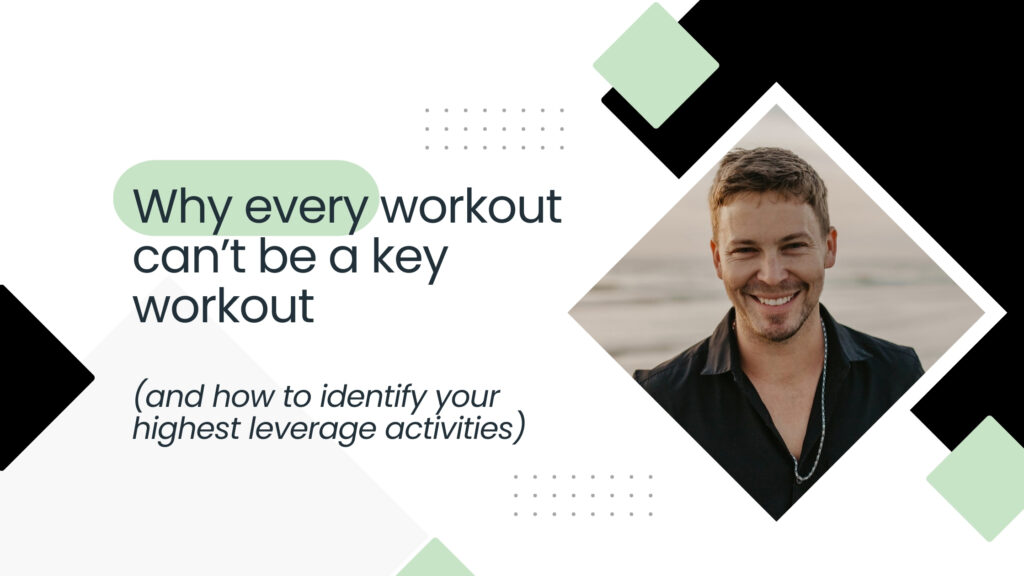A good training program includes a variety of intensities.
Whether you’re a runner, cross fitter, lifter, hybrid athlete, or class pass hopper you know what I’m talking about. You either work out hard two to three times a week or mix up the workouts so you don’t do the same thing every day. Even if you love leg day and want to build your legs you know you can’t do legs every day.
That’s why we intentionally or unintentionally design our training programs around key workouts.
If you’re a runner, that’s usually a long run, tempo run, and speed work each week.
If you’re a hybrid athlete or cross-fitter, you try balancing holistic strength with a long endurance session and short “met-cons” (high-intensity intervals).
If you’re a gym goer, you hit the muscle group you’re focused on more often.
If you are a casual athlete, you workout two to three times a week to maintain or build your overall health.
We all have key workouts.
What to know about key workouts.
Key workouts are the key to success
When you pick a fitness goal, you realize that certain workouts and activities are more beneficial to your success than others. For example, runners are notoriously small skinny people who don’t lift weights, but they don’t need to lift weights for their goal. Runners try to optimize their activity for their objective (they should still strength train though).
Key workouts serve as the activities with the highest leverage and potential to help you achieve your goals.
Essentially, key workouts are what is needed to achieve your goals, but we need to incorporate them thoughtfully.
Key workouts are usually the most intense workouts. Doing them too often or too close together can create burnout or injury.
Two to three a week is probably the ideal amount of sessions. The rest of your training and be accessory work our slower intensity workouts.
What do key workouts have to do with lifestyle design?
I love using fitness as an example because it’s taught me a lot about life.
Fitness isn’t just about your health. Fitness builds character and discipline. It introduces you to strategy and data analysis. It builds mental toughness. It also introduces a lot of concepts that aren’t just for fitness.
Key workouts isn’t a fitness concept, it’s a lifestyle design concept.
Like building our fitness, building a better life is a systematic process. In fitness, you have strength, power, vo2 max, endurance, and body composition goals. In life, you have career, family, friendship, health, personal growth, and faith goals
Identifying your key workouts in life is just as important as identifying them in fitness.
How to identify your key workouts
Even if you aren’t knowledgeable about training practices, you’ve experienced the physical consequences of doing too many key workouts in a week. You get sore, extra tired, and sometimes hurt.
It’s easy to look about and say “I did too much this week”.
But doing too many key workouts in life doesn’t feel the same. We don’t get physically beat up, we just get emotionally drained, less productive, less enthusiastic and optimistic, and burnt out. Suddenly, we feel stressed and anxious at work because every day feels like a grind. We feel disconnected or overwhelmed by our relationships because they aren’t being purposefully built, we look in the mirror and realize we’re heavier than we used to be because we haven’t been intentional with our training.
That’s why it’s so important to spend time identifying your key workouts in life.
Step 1: Identify what’s important to you.
You should know your life goals, but also your seasonal goals.
Unfortunately, it is very difficult to focus on more than one thing at a time. Something needs to get put on the back burner while you work on the most important piece.
Identify a couple of life goals you want to focus on in the coming season. There are just over three months left in the year, a perfect amount of time to build a life “training cycle”
Step 2: List 2-3 actions (or key workouts) you can take each week to support that goal
Once you know your goal or priority, start by listing actions you can take to achieve them.
These might be harder to identify, especially for more ambiguous goals, but the good news is these aren’t going to be written in stone, you can always change them.
Write out 2-3 key workouts for each week, when you want to do them, and why they’re important.
Step 3: Cap daily activity with a “two-do list” framework
After step 2, you might have a list of 5-10 things.
After all, if you’re like me, life is full. I have an amazing wife and friends, but I also have a career, health goals, personal goals, and hobbies I want to make time for.
That’s why I like to identify my daily “Two-do list”. It’s a list of two, and only two, items I focus on each day and it’s a fantastic framework for scheduling your key workouts.
It helps set my focus on what’s important, but it also keeps me from trying to do everything.
A quick, kind, warning
If you are new to trying to identify “key workouts” in life applying this might feel strange and unproductive, but the only way to have key workouts is to stop trying to make all of your workouts key.
Doing less helps you do more good work, but it means you do less busy work.
We are so accustomed to the idea that more is better. Pulling back could be painful, but in the end, it will be worth it. Doing more just to do more is the same thing as trying to make all your workouts key workouts.
The result is none of your workouts become key.







